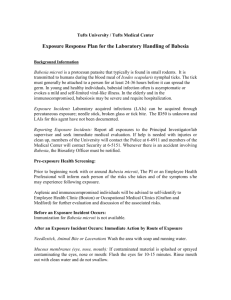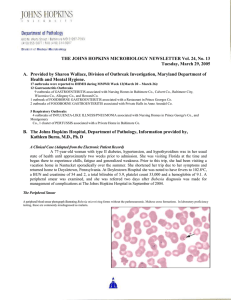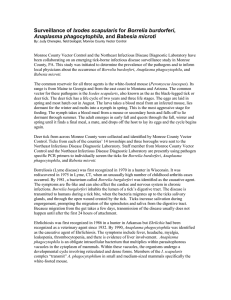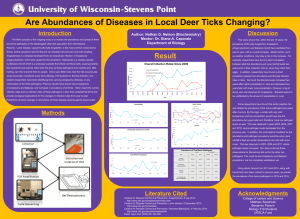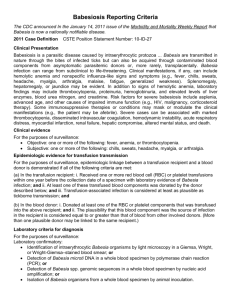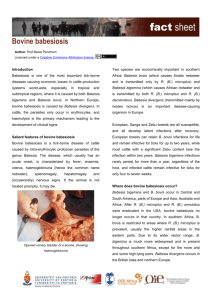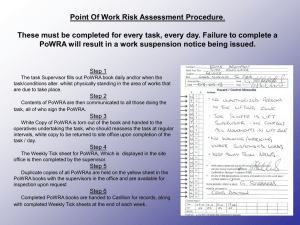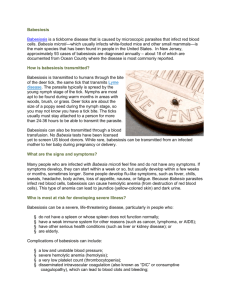Lecture: Babesia
advertisement
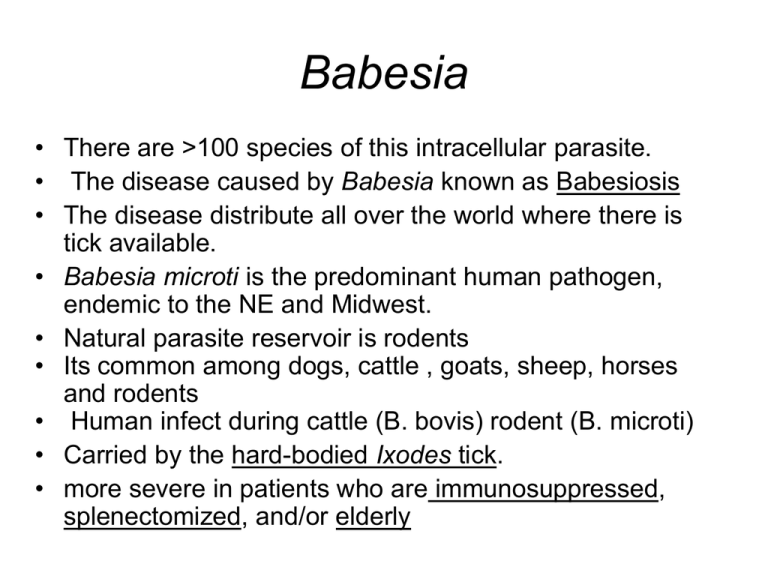
Babesia • There are >100 species of this intracellular parasite. • The disease caused by Babesia known as Babesiosis • The disease distribute all over the world where there is tick available. • Babesia microti is the predominant human pathogen, endemic to the NE and Midwest. • Natural parasite reservoir is rodents • Its common among dogs, cattle , goats, sheep, horses and rodents • Human infect during cattle (B. bovis) rodent (B. microti) • Carried by the hard-bodied Ixodes tick. • more severe in patients who are immunosuppressed, splenectomized, and/or elderly There are 17 species that infect domestic & wild animals all over the world, in Iraq there are 4 species that infect domestic animal and they are as follows: B. bigemina Cattel B. motasi Sheep B. equi Horses B. Caballi Horses The parasites reproduce by binary fission inside the R.B.Cs, after transmission with the tick saliva. Transmission • Tick bite • Transpalcental • Transfusion of infected blood Babesia life cycle • Numerous erythrocytes are infected with the predominantly ring or pear-shaped form of Babesia microti. • Pleomorphic rings with 1-3 chromotin dots per parasite. • 3 dots is unique for Babesia. High Power • Ring shaped trophozites • White eccentric “food • The intraerythrocytic vacuole” in a ring form. trophozoites multiply by • Very transient stage in binary fission or Malaria. Very rarely seen. schizogony, forming two to four separate merozoites. . The Famous Maltese Cross • Presence of 4 daughter merozoites in a tetrad is pathomnemonic. • However, rarely seen. • Never seen in malaria. Multiply Infected RBCs • RBCs can be infected with multiple organisms at the same time. Up to 12 parasites may infect a single RBC. • Plasmodium has up to 3 parasites/RBC. Other Sightings • Syncytium of extracellular parasites • more common in Babesia infections Babesiosis • Babesiosis (piroplasmosis) is a hemolytic disease similar to malaria but without an exoerythrocytic cycle. • Disease caused by B. divergens can be severe, even fatal, in splenectomized and debilitated patients (Most patients are older than 50 years of age). • B. microti causes a self-limiting febrile disease characterized by fatigue and anorexia. Clinical Symptoms • Ranges from asymptomatic infection to fatal illness (rare) • More severe infection tends to occur in immunnocompromised, elderly, and the very young. • The extreme end of the spectrum is often described as a malaria-like infection; symptoms may include Fever, sweating, chills, headache, anemia, jaundice, malaise, haemoglobinuria & Weakness. Diagnosis • Diagnosis is based on clinical suspicion and history of exposure. • Thick and thin smears remain most clinically used • However, it is necessary to examine 200 to 300 oil immersion fields before declaring a specimen negative. • Various PCR detection assays are available for detection of B microtic and other species. • More sensitive but also more time consuming and expensive. • Indirect fluorescent antibody test can also be used as a confirmatory test. Control and prevention 1. One should avoid tick exposure and, if bitten, remove the tick from the skin immediately. 2. Treatment of infected animals with available drugs . 3. Use of the Acaricides regularly & periodically in the endemic area.
